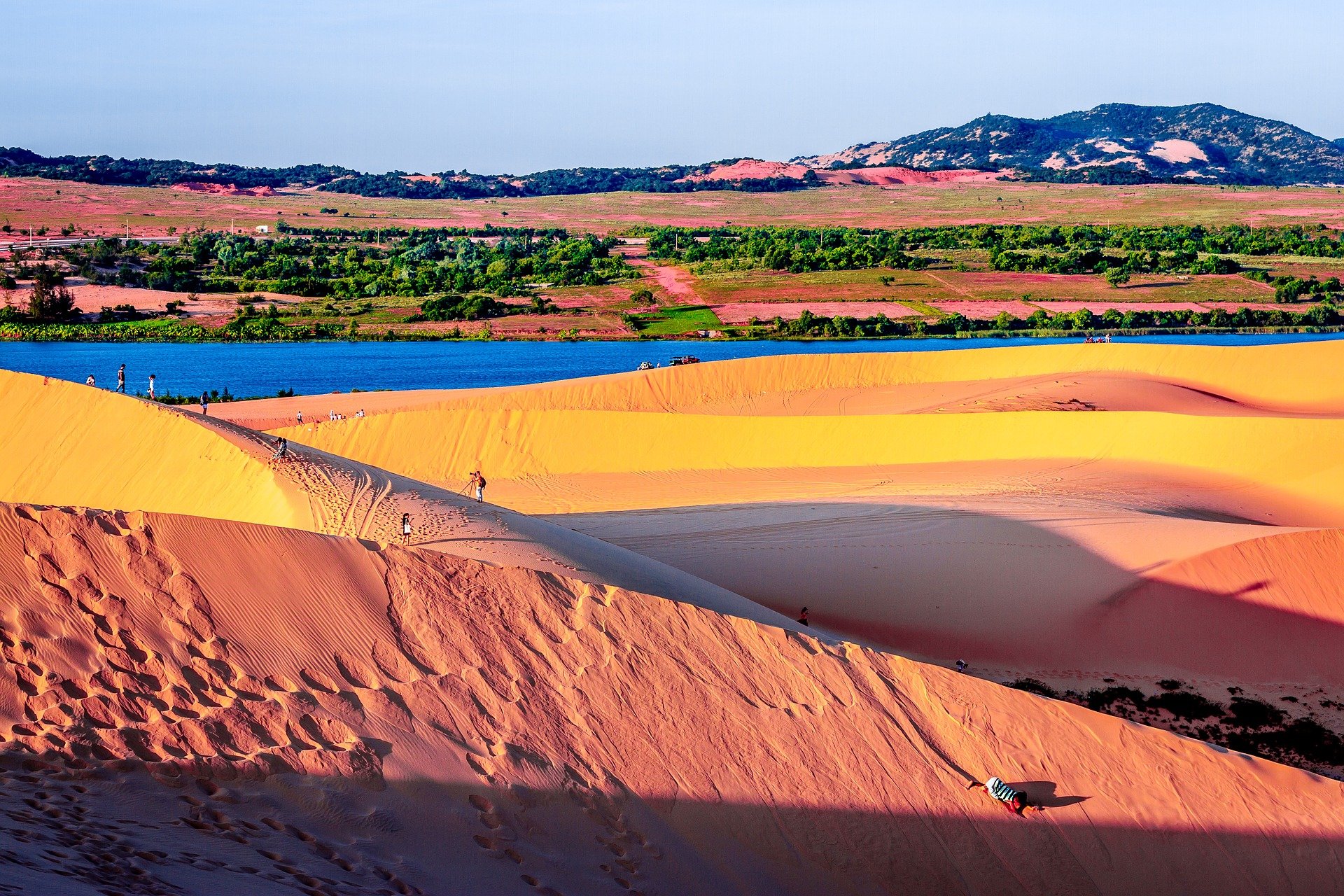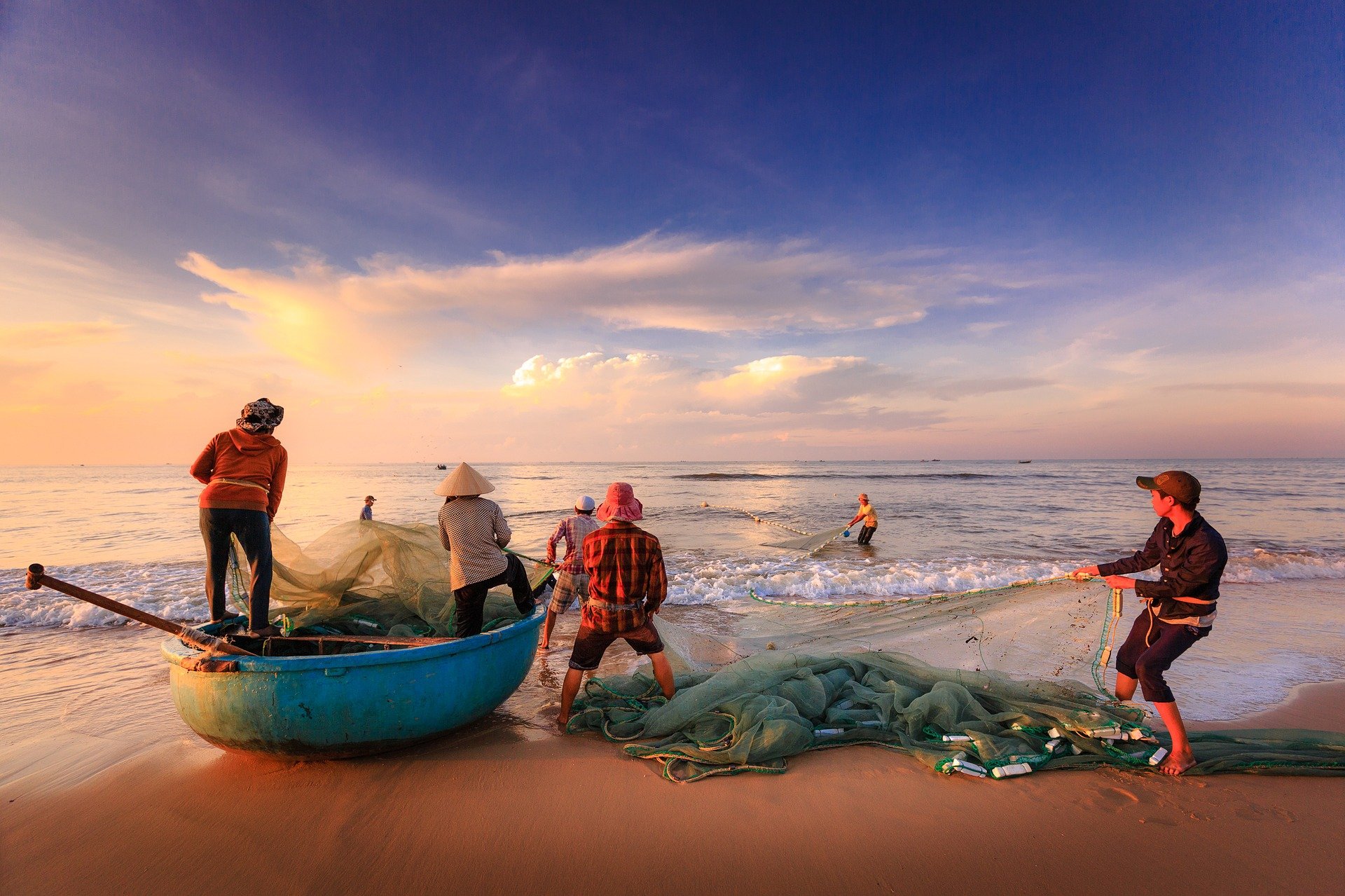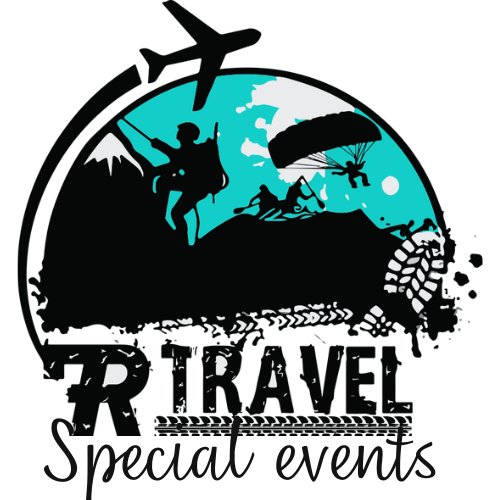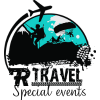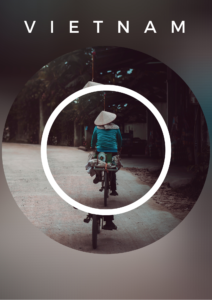Vietnam

Sports and adventures
Here are the sports and adventures we recommend in this destination.
For more details about sports click here.
- Canyoning: Dalat is the best place to experience this truly adrenaline-pumping activity, with jumps of 11 meters, abseiling up to 16 meters and … the washing machine 😉 There are also routes for beginners.
For more information read the worksheet about canyoning.
- Sandboarding: one of the many adventures that can be done in Mui Ne. Pristine sand dunes, the rising sun, perfect temperature, … and now down with the board at full speed!
Here you will find all the information on sandboarding.
- Kitesurfing: Mui Ne is also the ideal place for kitesurfing. You can have fun doing stunts, jumps and flights in the air.
More information on kitesurfing in the worksheet.
- Kayaking: you can kayak in many places in Vietnam, but the best is in Ha Long Bay, a UNESCO World Heritage Site, among hundreds of limestone islands that protrude from the water, shrouded in fog that makes this place even more impressive.
- Rock Climbing (we talked about it here): Vietnam offers endless opportunities, for both beginners and experts. But the real reason rock climbing enthusiasts from all over the world come here is because of its unique landscape and stunning views, overlooking limestone cliffs, such as Halong Bay.
- Trekking and hiking: one of the most exciting experiences is an excursion of a couple of days in contact with one of the families that populate the Sapa village. A much more challenging undertaking is the ascent to Mount Fansipan, 3,143 meters high, the highest peak in Indochina. It will take 3 days to reach the summit, but it will be worth it.
Read more about trekking and hiking.
- Diving: Vietnam offers a coastline of 3260 km, with most of the waters still unexplored and largely untouched dive sites, a true paradise for divers. Expect to see a rich coral reef full of dugongs, bamboo sharks, barracudas, nudibranchs, …
Read the diving worksheet.
- Mountain Biking: this is the perfect way to explore the countryside and there are many full-day and multi-day tours or routes, such as the 14-day Hanoi to Saigon tour. For a quieter excursion, Sapa is an area full of rolling green rice fields, perfect for exploring by bike.
Further information on biking and mountain biking in the worksheet.
- Caving: a perfect adventure for the adrenaline addicted is the descent along marble walls to explore a temple and caves in Hoi An, near Da Nang. But don’t miss the legendary Hang Son Doong, the largest cave in the world, so large that a Boeing B747 can fly through its largest opening.
All the info about caving.
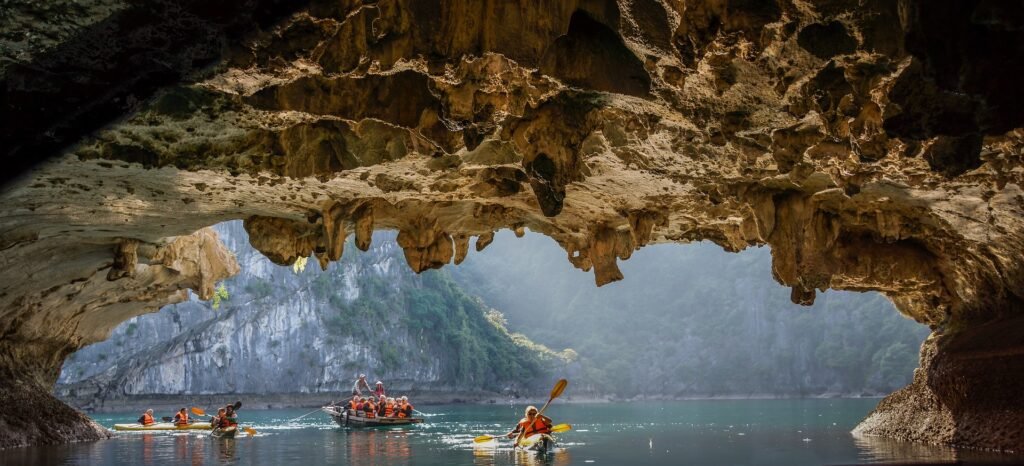
Kayaking in the Bat Cave
Experiences
Here are some of the unique and exciting experiences you could live in this destination:
- A food tour to get to know all the local dishes, especially street food and Saigon beer.
- A cooking class to learn how to make spring rolls, pho and other fantastic Vietnamese delicacies.
- Cliff Jump: the best place to jump is said to be Ba Ho Falls, about an hour from Nha Trang. Here is a stunning, isolated waterfall with crystal clear turquoise waters. You can get there by walking along a rather demanding and slippery road, but it is worth it.
- Vietnam Tour by motorbike: from Ho Chi Minh to Hanoi (or vice versa), through the country roads with breathtaking landscapes that surround you, or for shorter stretches, but with all the freedom that only the motorbike can offer.
- Bask on beautiful beaches: Mui Ne, Hoi An, Nha Trang, Phu Quoc Island,… In addition to a wonderful sea, these places offer the possibility of doing many outdoor activities.
- Tasting snake wine: it is an exotic drink produced with the infusion of snakes (mostly poisonous) in a jar of rice wine. It is sold in most markets and tourist shops. If you want to taste it with eight courses of snake-based delicacies, we recommend Le Mat Snack Village in Hanoi.
- Crawl through the secret tunnels of the Viet Cong: Located 70 km northwest of Ho Chi Minh City, the Cu Chi Historic Site is a network of nearly 500 km of underground tunnels, most of them equipped with trap doors, living areas, kitchens, storage facilities, armory, hospitals and command centers, used by the Viet Cong during the war with the United States in the 1960s. Highly not recommended for claustrophobic sufferers.
- See the terraced rice fields: in the Muong Hoa Valley you can take a tour to learn about how rice production works and take great photos of the magnificent Vietnamese countryside for your Instagram profile.
- Bargaining in local markets: in local markets you can taste authentic Vietnamese food in a lively atmosphere of colourful stalls selling fresh products, household items and clothing. You’ll also see old ladies smoking huge hand-rolled cigarettes and freshly slaughtered meat and fish. To buy something, bargaining with sellers is the best way to get a good price.
- Spend an evening in Bia Hoi Junction: located in the historic center of Hanoi. In the evening it is filled with plastic stools on which to sip local beers. There are also many street vendors selling steamed peanuts, jerky, and other exotic snacks.
- Swimming in Elephant Spring Natural Pools: about 50 km from Hue there is this group of natural springs where you can swim, hike and picnic. The areas are equipped to provide life jackets and changing cabins. There are also stalls offering snacks and drinks.
- Exploring the Paradise Cave: Phong Nha-Ke Bang National Park boasts over 300 caves, most of which are said to have formed over 400 million years ago. Paradise Cave features spectacular forms of limestone stalactites and stalagmites. Phong Nha-Ke Bang National Park is also a great place for mountain biking, bird watching and rainforest hiking.
- Spend a day with a family from the hill tribes in Sapa: one of the best ways to fully experience the local way of life is to spend time with a family in the traditional villages of Sapa, such as the Giay, Hmong and Red Dao tribe, who will be happy to host travellers in their homes, preparing authentic regional dishes, dressed in local customs.
- Visit a pagoda: they are all over the country and are characterized by beautiful carved sculptures. These places are used as shrines and temples.
- Sleeping in a super instagrammable resort: Ba Na Hills is a surreal resort. Upon arrival, visitors are greeted by a series of bridges, statues and water features that replicate the city of Hoi An in miniature. Inside it features numerous other quirks and attractions, including the Ba Na Cable Car, a cable car that holds the world record for its length and that in about twenty minutes, takes you to a French village complete with Gothic-style cathedral and French restaurants.
- See the Hon Khoi salt pans among the most unique destinations in the Phan Rang-Nha Trang area, where the procedures for the extraction, spreading and harvesting of salt are still carried out with the ancient techniques.
- Whatch the return to the village of women at sunset with baskets of rice and jars in Nam Cuong.
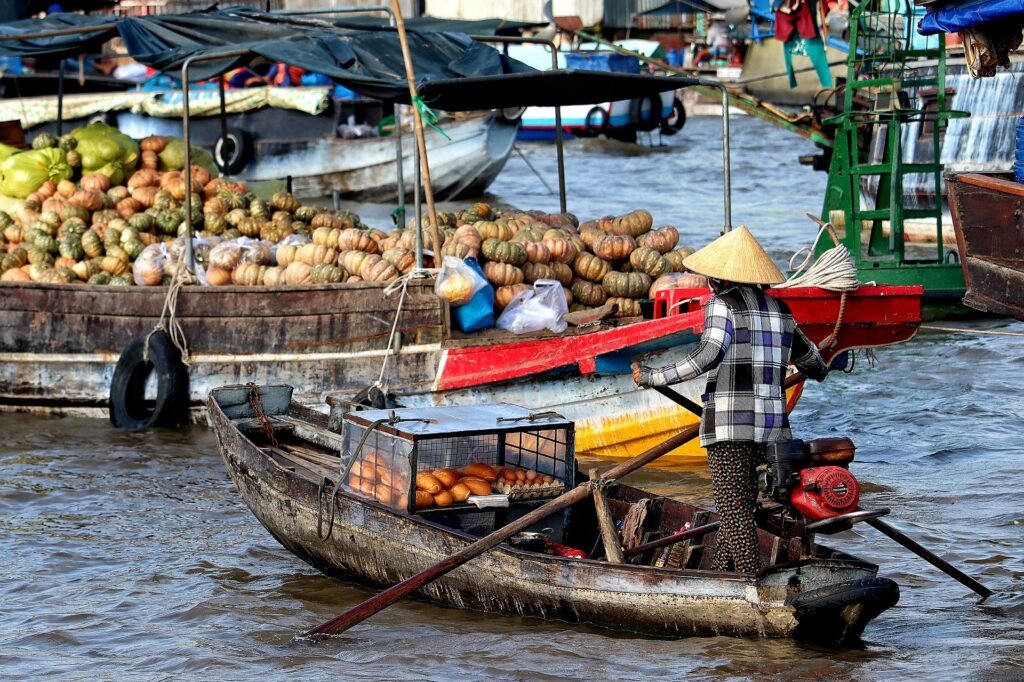
The market on the Mekong river
What to see
Vietnam offers wonderful locations that are absolutely worth visiting. Here you have some:
Vietnam can be divided into three main areas:
The North: for nature lovers, with scenic roads, fantastic limestone karst formations and the busy city of Hanoi.
The South: it is a very diversified area. There is Ho Chi Minh City, the busy city of Saigon; in the surroundings the delta of the Mekong river with the lively city of Can Tho in the middle. This area is also known for its beaches, coastal areas and islands. Phu Quoc and Con Dao are two ideal places to escape the chaos of the city. Mui Ne, Nha Trang and Dalat are ideal for those who love water sports, adrenaline and adventure.
Central Vietnam: here you can visit the historic cities of Hoi An, Danang and Hue. Banh Mi Phuong is also worth a visit. In this area you will also find the famous Marble Mountains, temples, beautiful beaches, history and culture.
In particular, we suggest not to miss:
- The Golden Bridge, (in Vietnamese, Cau Vang), is a pedestrian bridge, characterized by two gigantic stone hands that support it, creating an optical suspension effect. It was built along the Annamite Range, a mountain range over a thousand kilometers long that crosses Laos, Cambodia and Vietnam.
- Hoi An: UNESCO heritage city, to visit by bike. This quaint town is the perfect mix of new and old architecture. The food here is amazing. Its historic center is a living museum that houses Chinese temples, a bridge designed in Japan, traditional markets, wooden shops, French colonial houses, and old canals.
- Ho Chi Minh: is a chaotic and crowded city that offers numerous opportunities to taste craft beer and a wide choice of traditional dishes. Visit the War Museum, the Reunification Palace and Notre Dame Cathedral.
- Hanoi: another big city, a little quieter than Ho Chi Minh. The ideal way to visit the city is to stroll along the picturesque Hoan Kiem Lake, see the Nha Tho Cathedral and the historic center. Hanoi is full of trendy clubs and restaurants, but for an authentic experience, the ideal is to sit by the many Vietnamese sidewalk barbecues and taste their offerings.
- Mui Ne: white and red sand dunes, beaches and outdoor activities, multicolored limestone formations, this is Mui Ne.
- Hue: this ancient town used to be the royal city of Vietnam and is the ideal place for history lovers with its pagodas, emperor tombs and the fortress.
- Sapa: is one of the most scenic places in Vietnam, with its rolling hills and mountains, endless rice terraces with breathtaking views. To experience Sapa at its best you can stay with the locals. Bac Ha market and Coc Ly market are worth a visit. From Sapa there are numerous paths for trekking and hiking.
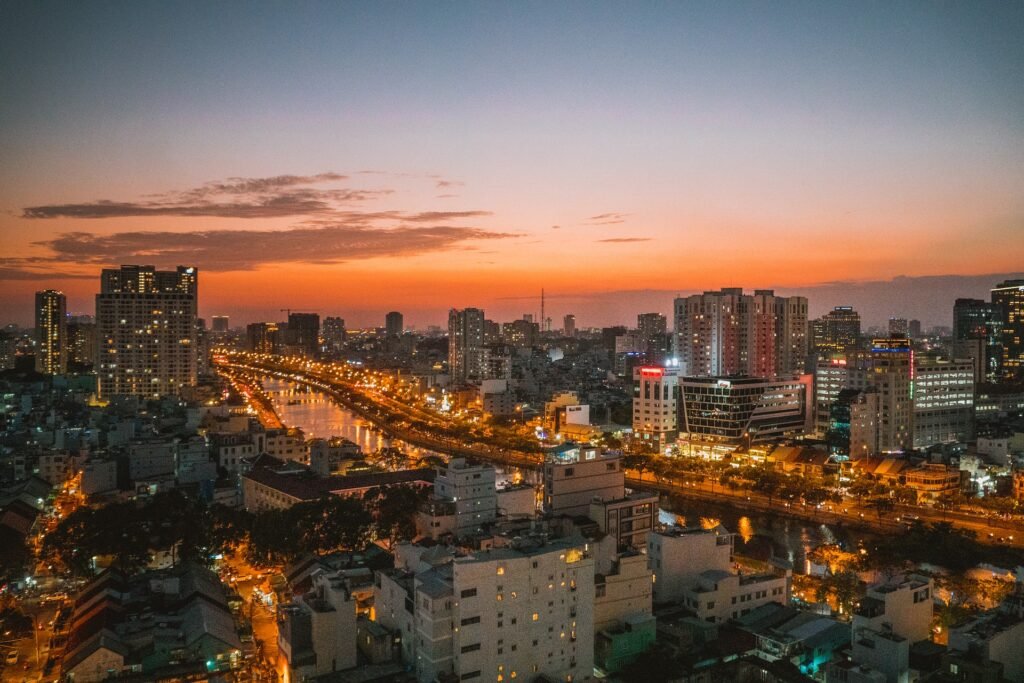
Saigon by night
Food and Wine
Vietnam is one of the places where you can find the best street food in the world. And it is also very very cheap. A food tour of Vietnam is definitely recommended.
Among the typical dishes we recommend:
Gôi Cuon, or Vietnamese spring rolls, made from rice paper, noodles, fish or meat (usually shrimp or pork), then flavored with fresh herbs. They are usually served with a sweet soy sauce topped with roasted peanuts and chilli.
Bun Cha Hanoi: grilled meat served with noodles, with a sweet but spicy broth to pour over the noodles.
Pho: is one of the most popular dishes. It’s a beef soup and usually eaten for… breakfast! The basis of Vietnamese pho is meat broth that is cooked for many hours with the addition of onions, ginger and other spices. Everyone can then customize the dish with the ingredients they prefer, from slices of raw meat that they will cook directly in the boiling broth to the most varied aromas such as coriander, spring onion, chilli or lime.
Bánh Xèo: savory pancake, stuffed with pork, shrimp, green onions and bean sprouts. It is served with mixed greens such as mustard leaves, basil, mint and lettuce, which is then used to wrap the pancake. It is served with a sweet and sour fish sauce that goes perfectly with all flavors.
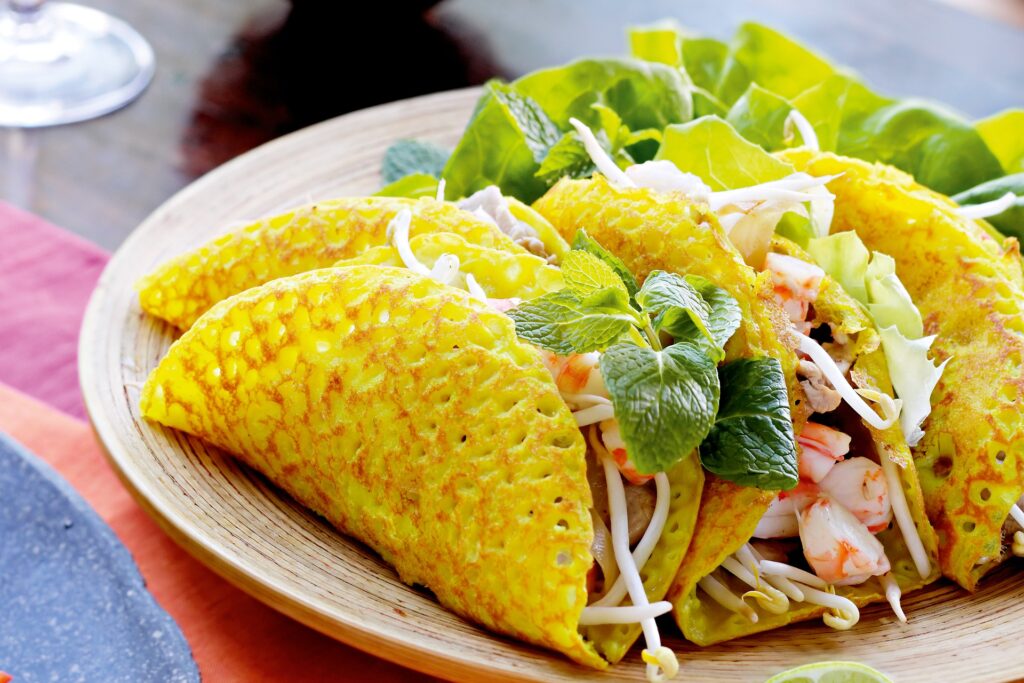
Bành Xèo
When to go
In general, Vietnam can be visited almost all year round. From February to April and from August to October are the periods in which temperatures are less intense and rainfall is scarcer.
What is the best time to dive in Vietnam?
The dive sites are accessible all year round, but the best time to dive is from March to October, for better visibility and calmer currents. Always keep in mind that the weather can vary greatly from one place to another in Vietnam, so it is always necessary to check the conditions before planning a dive.
What to pack
Of course, what to pack for a trip to Vietnam depends on what activities you will do and, above all, on the period when you go there.
Below we give you just a few indications on what absolutely must not be missing.
For most of the year, Vietnam is hot. Even during the monsoon season, it is hot despite the continuous rain.
There are some places in the country where temperatures are cooler.
In general, expect heat and humidity.
Cool and light clothing
Long-sleeved shirts
Light sweater
Rain jacket
Comfortable shoes for walking in the cities
Trekking boots
Swimwear
Sun hat
Sunglasses
Sun creams
Insect repellent
Keep space in your suitcase to buy some clothing in Vietnam, they are very cheap!
Information
Continent: Asia
Capital: Hanoi
Language: Vietnamese. English is also spoken in larger cities.
Currency: Vietnamese Dong – VND – ₫. The US Dollar is also accepted in some places.
Electricity & Plug Type: AC 220V. It is used type C sockets, often compatible with the standard US plug or even the European one.
For up-to-date and detailed information visit www.viaggiaresicuri.it
Some tips
As you won’t always be able to find people who speak English, it may be helpful to learn a few terms in Vietnamese. Here are a few:
Hello: Xin chào
Goodbye: Tạm biệt
Thank you: Cám ơn
Nothing too spicy, please: Lam on moi thu khong qua cay
How much? Bao nhieu?
Is there anything cheaper? Ban co gia nao re hon khong?
